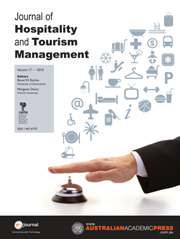Crossref Citations
This article has been cited by the following publications. This list is generated based on data provided by
Crossref.
Tapescu, Alina Ioana Mihaela
2015.
Romanian versus Bulgarian Tourism Labour Market Analysis.
Procedia Economics and Finance,
Vol. 27,
Issue. ,
p.
375.
Brown, Eric A.
Thomas, Nicholas J.
and
Bosselman, Robert H.
2015.
Are they leaving or staying: A qualitative analysis of turnover issues for Generation Y hospitality employees with a hospitality education.
International Journal of Hospitality Management,
Vol. 46,
Issue. ,
p.
130.
Ladkin, Adele
and
Buhalis, Dimitrios
2016.
Online and social media recruitment.
International Journal of Contemporary Hospitality Management,
Vol. 28,
Issue. 2,
p.
327.
Maria-Cristina, Iorgulescu
and
Ioana, Ţăpescu Alina
2016.
Entrepreneurship, Business and Economics - Vol. 1.
Vol. 3/1,
Issue. ,
p.
183.
Robinson, Richard N.S.
Ruhanen, Lisa
and
Breakey, Noreen M.
2016.
Tourism and hospitality internships: influences on student career aspirations.
Current Issues in Tourism,
Vol. 19,
Issue. 6,
p.
513.
Baum, Tom
Cheung, Catherine
Kong, Haiyan
Kralj, Anna
Mooney, Shelagh
Nguyễn Thị Thanh, Hải
Ramachandran, Sridar
Dropulić Ružić, Marinela
and
Siow, May
2016.
Sustainability and the Tourism and Hospitality Workforce: A Thematic Analysis.
Sustainability,
Vol. 8,
Issue. 8,
p.
809.
Stone, Matthew J.
Padron, Thomas C.
Wray, Michael L.
La Lopa, Joseph “Mick”
and
Olson, Eric D.
2017.
Career desires and expectations of event management students.
Journal of Hospitality and Tourism Management,
Vol. 32,
Issue. ,
p.
45.
Ezeuduji, Ikechukwu O.
Chibe, Mumsy E.
and
Nyathela, Tshinakaho
2017.
Hospitality management study programme and students’ perceptions: universities in South Africa.
Journal of Teaching in Travel & Tourism,
Vol. 17,
Issue. 4,
p.
313.
Aloudat, Areej Shabib
2017.
Undergraduate students’ perceptions of a tour-guiding career.
Scandinavian Journal of Hospitality and Tourism,
Vol. 17,
Issue. 4,
p.
333.
Shum, Cass
Gatling, Anthony
and
Shoemaker, Stowe
2018.
A model of hospitality leadership competency for frontline and director-level managers: Which competencies matter more?.
International Journal of Hospitality Management,
Vol. 74,
Issue. ,
p.
57.
Le, Anh Hai
Klieve, Helen
and
McDonald, Christine V.
2018.
Tertiary students’ perceptions of hospitality careers in Vietnam.
Empirical Research in Vocational Education and Training,
Vol. 10,
Issue. 1,
Sakdiyakorn, Malinvisa
and
Wattanacharoensil, Walanchalee
2018.
Generational Diversity in the Workplace: A Systematic Review in the Hospitality Context.
Cornell Hospitality Quarterly,
Vol. 59,
Issue. 2,
p.
135.
Tanwar, Karnica
and
Kumar, Amresh
2019.
Employer brand, person-organisation fit and employer of choice.
Personnel Review,
Vol. 48,
Issue. 3,
p.
799.
Tan, Kim-Lim
Lew, Tek-Yew
and
Sim, Adriel K.S.
2019.
An innovative solution to leverage meaningful work to attract, retain and manage Generation Y employees in Singapore’s hotel industry.
Worldwide Hospitality and Tourism Themes,
Vol. 11,
Issue. 2,
p.
204.
Kuhzady, Salar
Çakici, Celil
Olya, Hossein
Mohajer, Boshra
and
Han, Heesup
2020.
Couchsurfing involvement in non-profit peer-to-peer accommodations and its impact on destination image, familiarity, and behavioral intentions.
Journal of Hospitality and Tourism Management,
Vol. 44,
Issue. ,
p.
131.
Şengel, Ümit
Genç, Gökhan
and
Zengin, Burhanettin
2020.
Expectation differences between the tourism sector and students: A comparative analysis.
European Journal of Tourism, Hospitality and Recreation,
Vol. 10,
Issue. 2,
p.
177.
Chu, Samuel Kai Wah
2020.
Social Media Tools in Experiential Internship Learning.
p.
31.
Siow, May Ling
Lockstone-Binney, Leonie
Fraser, Barry
Cheung, Catherine
Shin, Joongwon
Lam, Rachel
Ramachandran, Sridar
Novais, Margarida Abreu
Bourkel, Tom
and
Baum, Tom
2021.
Re-Building Students’ Post-COVID-19 Confidence in Courses, Curriculum and Careers for Tourism, Hospitality, and Events.
Journal of Hospitality & Tourism Education,
Vol. 33,
Issue. 4,
p.
270.
Griffin, Mamie
Hodgson, Renata
and
Sivam, Sathya
2021.
Career incentives, career deterrents, and cultural blocks: An investigation of factors impacting female Emirati students’ perceptions of tourism.
Journal of Human Resources in Hospitality & Tourism,
Vol. 20,
Issue. 3,
p.
472.
Formádi, Katalin
and
Gyurácz-Németh, Petra
2021.
Turisztikai karrierperspektívák vizsgálata a Covid19- járvány árnyékában – Turizmus-menedzsment mesterszakos hallgatók percepciói.
Turizmus Bulletin,
Vol. 21,
Issue. 4,
p.
14.


